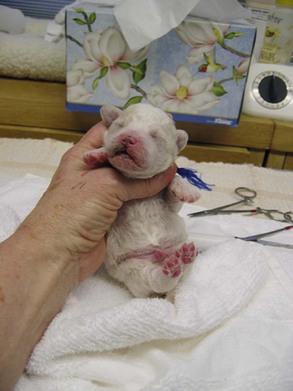CHAPTER 3 History and Physical Examination of the Neonate
In this chapter, the neonatal period is defined as the period from birth through 3 weeks of age, or when the puppy or kitten is walking and capable of spontaneous urination and defecation. Box 3-1 contains a general overview of important parameters in the physical examination of neonatal dogs and cats.
BOX 3-1 Important parameters in physical examination of neonatal dogs and cats
Collecting a Comprehensive History
Physical Examination
The timing of significant events in pediatric development can be found in Table 3-1.
TABLE 3-1 Timing of significant events in pediatric development
| Event | Age at occurrence |
|---|---|
| Umbilical cord dries and falls off | 2-3 days |
| Eyelids open | 5-14 days |
| External ear canals open | 6-14 days |
| Extensor dominance | 5 days |
| Capable of crawling | 7-14 days |
| Capable of walking, urinating, and defecating spontaneously | 14-21 days |
| Hematocrit/RBC number stabilize near that of adult | 8 weeks |
| Renal function nears that of adult | 8 weeks |
| Hepatic function nears that of adult | 4-5 months |
RBC, Red blood cell.
Apgar Scoring
Human neonates are scored for various viability measures at birth. The scoring system used was developed by Virginia Apgar, MD, and bears her name. A similar scoring system has been proposed for neonatal dogs and cats (Table 3-2). At present, there are no studies correlating viability scores at birth with morbidity or mortality in puppies or kittens. This system may be most useful as a way of consistently reevaluating an ill puppy or kitten during hospitalization or if they are presented repeatedly. This system provides an objective measure for the medical record for this individual and may be used to guide urgency of diagnostics or alterations in treatment by the veterinary staff.
Hydration Status
Hydration status can be difficult to assess in neonatal puppies and kittens. Skin turgor or tenting is not as accurate an indicator of hydration status in pediatric animals as it is in adult animals because neonates have less subcutaneous fat. Well-hydrated puppies and kittens with light pigmentation normally have fairly deep pink coloration of the ventrum, muzzle, and oral mucous membranes (Figure 3-1). There is deepening to dark pink or red with dehydration, but this is a very subjective measure. Oral and ocular mucous membranes may be dry in dehydrated animals. Caution should be used when assessing oral mucous membranes in animals that have recently nursed; milk on the mucous membranes will make them feel slick, artifactually suggesting normal hydration. Normal urine in neonatal animals is very dilute with no discernible color. Stimulation of urination by gentle manipulation of the genitalia with a moistened cotton ball allows one to assess color of urine; any yellow color suggests dehydration is present. Packed cell volume (PCV) cannot be used as a measure of hydration in neonatal puppies and kittens because there is variation in the number of red blood cells (RBCs) passed through the placenta and umbilicus at the time of parturition and because there is a normal decline in PCV with age until it stabilizes at about 8 weeks of age.
Stay updated, free articles. Join our Telegram channel

Full access? Get Clinical Tree




